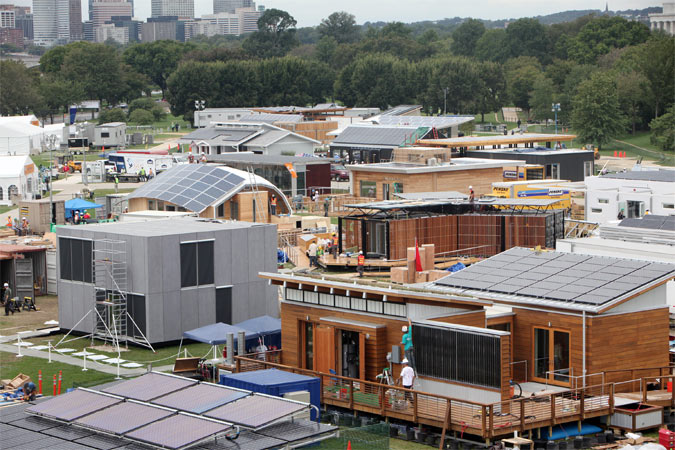
For the fifth time since its launch in 2002, the U.S. Department of Energy’s Solar Decathlon kicked off on September 23 in Washington, D.C. But following complaints that the collegiate design-build contest was damaging the mall’s lawn, it was moved to a new location along an isolated stretch of the National Mall tucked between the Tidal Basin and the Potomac River. The new site feels more rural than urban. This year’s village, which used to extend down the Mall in two long rows, was instead compactly arranged along four lanes. It was open to the public through October 2.
Over the past two years, 20 student teams from around the United States, and from Canada, Belgium, New Zealand and China, have designed and built sustainable, energy-efficient houses for the contest. (Only 19 are on display; Team Hawaii withdrew.) Overall, the houses seem more modest and less technology-driven than the last time, which is largely due to a new component in the judging: affordability. Whereas 2009’s winning house, built by Team Germany, cost upwards of $650,000, this year’s contestants get points for keeping costs below $250,000 and are effectively penalized if they spend more than $600,000.
Modest might not be an obvious descriptor for CHIP (“Compact Hyper-Insulated Prototype”), entered by a joint SCI-Arc/California Institute of Technology team. The edgiest of the Decathlon houses architecturally, CHIP is a torqued and faceted box, wrapped in a thick quilt of insulation topped with heavy-duty white vinyl—the little house in a parka. But the distinctive skin is highly efficient and affordable, team members say, and inside, CHIP is no-frills, furnished with only a dining table, a mattress, and custom-fabricated chairs and ottomans that fit like puzzle pieces into a wall storage space.
|
Teams put the finishing touches on their Solar Decathlon houses to be on display through October 2.
U.S. Department of Energy
|
||
Team Belgium and Team New Jersey also departed from the wood-slats-and-louvers paradigm. The Belgians’ E-Cube features an exposed industrial pallet-racking structure and a fiber-cement-board facade, while ENJOY, the New Jersey house, is made of precast concrete, with an inverted hip roof that appears to float above clerestory windows. However, most of the houses use a vocabulary that will be familiar to the average American homebuyer. (Another category for the judges: “market appeal.”) As in past Decathlons, a number of teams drew on vernacular traditions, including Appalachian State University (homesteads with outbuildings) and Middlebury College (the New England farmhouse). Purdue University embraced market viability as a guiding principle of the INhome, a more compact and efficient version of the typical production home but with a self-watering biowall, something K. Hovnanian doesn’t offer as standard.
Three projects illustrate the recent shift toward social design. Team New York’s Solar Roofpod is intended to sit on top of a mid-rise building, making the most of underutilized air rights. The University of Illinois at Urbana-Champaign’s Re-home offers relief shelter for a family affected by a tornado or other natural disaster. The socially conscious standout is Empowerhouse, a three-way collaboration among The New School’s Parsons and Milano schools and the Stevens Institute of Technology. Working with the D.C. Department of Housing and Community Development and Habitat for Humanity, the team designed the house for a permanent site in the Deanwood neighborhood of Washington. There, team members and Habitat volunteers will expand it into a duplex for two local families.
In 2009, the Decathlon logged more than 300,000 visitors. Shuttle buses brought visitors from the Smithsonian Metro station, 1.3 miles away in an effort to match that number. Elisabeth Neigert, project manager for the SCI-Arc/Caltech team, said she’s happy that the event is still on the Mall, albeit not centrally located. “There are pros and cons,” she said. “It’s still accessible for the public, and actually, assembly is easier because of the route for the trucks.” She added: “I do wish, and think it would be a nice gesture, for our government to invite us back to the National Mall proper for 2013."